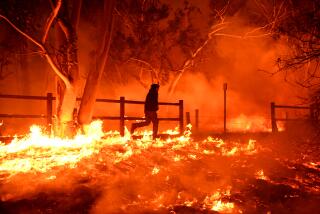Drones, cameras and metal detectors: Edison faces new scrutiny over start of Eaton fire

- Share via
Amid drones, long-distance camera lenses and metal detectors, a hillside in Eaton Canyon has become the focus of intense scrutiny over the last month by teams of private investigators now seeking clues on whether Southern California Edison equipment caused the massive fire that destroyed large swaths of Altadena.
Some of the findings and theories of these privately hired teams of fire investigators and electrical engineers have emerged in more than 40 lawsuits that residents have filed against the utility. Much of the focus has been centered on a group of transmission towers where the first flames were seen just as the Eaton fire exploded.
Earlier this week, a new lawsuit alleged that an idle transmission tower on the hillside — one that has not been in use for more than 50 years — might have sparked the devastating blaze.
1

2

3

1. Attorneys suing Southern California Edison, in a lawsuit, allege that a grounding wire for Edison’s transmission tower M16T1 was improperly grounded, and that about 4 feet of wire was exposed and could have come into contact with vegetation. 2. Attorneys suing Southern California Edison allege that dark markings found on Edison’s transmission tower M16T1, suggest the idle tower was somehow energized showed signs of arcing. 3. (Robertson and Associates, LLP)
The stakes are high. With more than 9,000 homes lost and 17 people killed, liability is going to be a costly question that could affect how Altadena is rebuilt.
Edison has been under scrutiny since the beginning because residents who live in Eaton Canyon took photos and videos showing a fire burning under a transmission tower just as the blaze started.
Last week, Edison revealed that its lines over Eaton Canyon saw a momentary increase of electrical current about the same time as the fire began. In a filing to California regulators on Jan. 27, Edison said a fault occurred on the Eagle Rock-Gould line about five circuit miles from the area where the fire started and caused an increase of current across the company’s transmission lines.
On Thursday, Edison went a step further, acknowledging that videos and other evidence suggested the company’s equipment may have played a role. However, the company added that so far, it “has not identified typical or obvious indications that would support this association, such as broken conductors, fresh arc marks in the preliminary origin area, or evidence of faults on the energized lines running through the area.”
The California Department of Forestry and Fire Protection has been examining the transmission line, but it has declined to comment on the probe and when it could be completed.
A lawsuit filed this week focused on Edison tower M16T1, which has been idle since 1971.
No electricity has been directed through the wires of the tower for more than 50 years, but investigators hired by a law firm suing Southern California Edison suspect that tower M16T1 was somehow re-energized on Jan. 7, sending electricity through the wires and tower, possibly sparking the fire.
Blackened marks and other signs of damage on the steel structure suggest that arcing occurred, sending electricity through the equipment that was supposed to have been unused, according a new lawsuit filed this week.
“This tower just got cooked from the top to the bottom,” said Alexander Robertson, an attorney from the firm Robertson and Associates LLP. “The working theory is that there was an electrical event and those abandoned lines got re-energized.”
The lawsuit includes close-up photographs of M16T1, including black markings on the tower that attorneys allege are signs of recent arcing.
“Marks at the top of the tower prove arcing happened,” Robertson added. “If [the markings] were old, they’d be oxidized and they wouldn’t be dark dark black.”
Robertson believes that the idle tower somehow was re-energized when the fire started.
Edison told state regulators Thursday it had discovered irregularities with its equipment in the area. Those irregularities included flashes of white light that utility workers observed near towers and transmission lines — including tower M16T1 — 12 days after the fire was sparked.
But Edison said it had not found signs of arcing on the towers, contradicting the allegations made by firms suing the company.
“A comparison between pre-fire and post-fire photos of the M16T1 structure does not show obvious signs of arcing or material changes in the condition of the tower,” according to the filing.
A spokesperson for Southern California Edison did not address questions regarding the possibility the tower was re-energized at the time of the fire.
The Washington Post was the first to report the theory of the idle tower.
“While we do not yet know what caused the Eaton wildfire, SCE is exploring every possibility in its investigation, including the possibility that SCE’s equipment was involved,” said Pedro J. Pizarro, president and CEO of SCE’s parent company, Edison International.
Los Angeles County Fire and Cal Fire are investigating the official cause of the Eaton fire, but the inquiry could take months to complete.
Today, four weeks after the fire scorched thousands of acres, more than 40 lawsuits from more than 600 residents have been filed against Southern California Edison, accusing the utility and its equipment of igniting the blaze.
So far, all of the lawsuits related to the Eaton fire have focused on Edison, its equipment and questions over how the company maintained areas surrounding its electrical towers.
More to Read
Sign up for Essential California
The most important California stories and recommendations in your inbox every morning.
You may occasionally receive promotional content from the Los Angeles Times.











